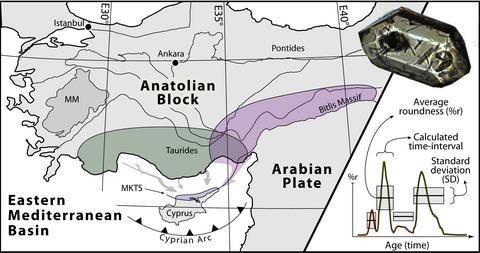当前位置:
X-MOL 学术
›
Basin Res.
›
论文详情
Our official English website, www.x-mol.net, welcomes your
feedback! (Note: you will need to create a separate account there.)
Drainage response to Arabia–Eurasia collision: Insights from provenance examination of the Cyprian Kythrea flysch (Eastern Mediterranean Basin)
Basin Research ( IF 2.8 ) Pub Date : 2020-04-10 , DOI: 10.1111/bre.12452 Uri Shaanan 1 , Dov Avigad 1 , Navot Morag 2 , Talip Güngör 3 , Axel Gerdes 4
Basin Research ( IF 2.8 ) Pub Date : 2020-04-10 , DOI: 10.1111/bre.12452 Uri Shaanan 1 , Dov Avigad 1 , Navot Morag 2 , Talip Güngör 3 , Axel Gerdes 4
Affiliation

|
The Cenozoic geodynamics of the north‐eastern Mediterranean Basin have been dominated by the subduction of the African Plate under Eurasia. A trench‐parallel crustal‐scale thrust system (Misis–Kyrenia Thrust System) dissects the southern margin of the overriding plate and forms the structural grain and surface expression of northern Cyprus. Late Eocene to Miocene flysch of the Kythrea (Değirmenlik) Group is exposed throughout northern Cyprus, both at the hanging‐wall and foot‐wall of the thrust system, permitting access to an extensive Cenozoic sedimentary record of the basin. We report the results of a combined examination of detrital zircon and rutile U–Pb geochronology (572 concordant ages), coupled with Th/U ratios, Hf isotopic data and quantitative assessment of grain morphology of detrital zircon from four formations (5 samples) from the Kythrea flysch. These data provide a line of independent evidence for the existence of two different sediment transportation systems that discharged detritus into the basin between the late Eocene and late Miocene. Unique characteristics of each transport system are defined and a sediment unmixing calculation is demonstrated and explained. The first system transported almost exclusively North Gondwana‐type, Precambrian‐aged detrital zircon sourced from siliciclastic rock units in southern Anatolia. A different drainage system is revealed by the middle to late Miocene flysch sequence that is dominated by Late Cretaceous–Cenozoic‐aged detrital zircon, whose age range is consistent with the magmatic episodicity of southeast Anatolia, along the Arabia–Eurasia suture zone. Deposition of these late Miocene strata took place thereupon closure of the Tethyan Seaway and African–Eurasian faunal exchange, and overlap in time with a pronounced uplift of eastern Anatolia. Our analytical data indicate the onset of prominent suture‐parallel sediment transport from the collision zone of south‐eastern Anatolia into the Kyrenia Range of northern Cyprus, marking the drainage response to the continental collision between Arabia and Eurasia.
中文翻译:

阿拉伯-欧亚大陆碰撞的排水反应:塞浦路斯南部基思里亚飞蝇(地中海盆地)物源检验的见解
东北地中海盆地的新生代地球动力学主要由欧亚大陆下的非洲板块俯冲作用所主导。平行于沟槽的地壳尺度推力系统(Misis–Kyrenia推力系统)剖析了上覆板块的南缘,并形成了塞浦路斯北部的结构性颗粒和表面表现。Kythrea(Değirmenlik)组的始新世晚期至中新世复飞期在整个塞浦路斯北部都暴露在推力系统的上盘和下盘,从而可以获取该盆地广泛的新生代沉积记录。我们报告了碎屑锆石和金红石U–Pb年代学(572个一致年龄)的综合检查结果,以及Th / U比,来自Kythrea flysch的四个岩层(5个样品)的同位素数据和碎屑锆石晶粒形态的定量评估。这些数据提供了一系列独立的证据,表明存在两种不同的泥沙输送系统,它们将碎屑排放到始新世末期和中新世末期之间的盆地中。定义了每个运输系统的独特特征,并演示和解释了泥沙分解计算。第一个系统几乎全部运输了来自安纳托利亚南部硅质碎屑岩单元的北冈瓦纳型,前寒武纪的碎屑锆石。中新世复飞石序列的中晚期揭示了不同的排水系统,白垩纪-新生代年龄碎屑锆石占主导地位,其年龄范围与安那托利亚东南部沿阿拉伯-欧亚大陆缝线带的岩浆性暴发相一致。这些晚中新世地层的沉积发生在特提斯海道的关闭和非洲-欧亚动物群的交换上,并随着时间的推移与安纳托利亚东部的明显隆升重叠。我们的分析数据表明,从东南安纳托利亚的碰撞带到塞浦路斯北部的凯里尼亚山脉,出现了明显的缝线平行沉积物运移,标志着排水对阿拉伯和欧亚大陆之间的碰撞产生了响应。
更新日期:2020-04-10
中文翻译:

阿拉伯-欧亚大陆碰撞的排水反应:塞浦路斯南部基思里亚飞蝇(地中海盆地)物源检验的见解
东北地中海盆地的新生代地球动力学主要由欧亚大陆下的非洲板块俯冲作用所主导。平行于沟槽的地壳尺度推力系统(Misis–Kyrenia推力系统)剖析了上覆板块的南缘,并形成了塞浦路斯北部的结构性颗粒和表面表现。Kythrea(Değirmenlik)组的始新世晚期至中新世复飞期在整个塞浦路斯北部都暴露在推力系统的上盘和下盘,从而可以获取该盆地广泛的新生代沉积记录。我们报告了碎屑锆石和金红石U–Pb年代学(572个一致年龄)的综合检查结果,以及Th / U比,来自Kythrea flysch的四个岩层(5个样品)的同位素数据和碎屑锆石晶粒形态的定量评估。这些数据提供了一系列独立的证据,表明存在两种不同的泥沙输送系统,它们将碎屑排放到始新世末期和中新世末期之间的盆地中。定义了每个运输系统的独特特征,并演示和解释了泥沙分解计算。第一个系统几乎全部运输了来自安纳托利亚南部硅质碎屑岩单元的北冈瓦纳型,前寒武纪的碎屑锆石。中新世复飞石序列的中晚期揭示了不同的排水系统,白垩纪-新生代年龄碎屑锆石占主导地位,其年龄范围与安那托利亚东南部沿阿拉伯-欧亚大陆缝线带的岩浆性暴发相一致。这些晚中新世地层的沉积发生在特提斯海道的关闭和非洲-欧亚动物群的交换上,并随着时间的推移与安纳托利亚东部的明显隆升重叠。我们的分析数据表明,从东南安纳托利亚的碰撞带到塞浦路斯北部的凯里尼亚山脉,出现了明显的缝线平行沉积物运移,标志着排水对阿拉伯和欧亚大陆之间的碰撞产生了响应。











































 京公网安备 11010802027423号
京公网安备 11010802027423号